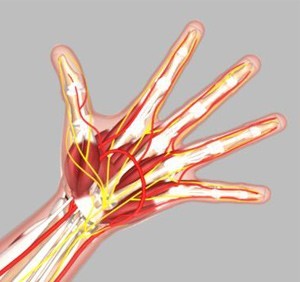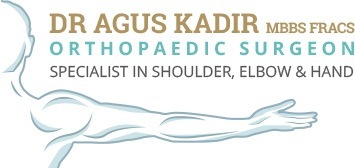Normal Hand Anatomy

The hand in the human body is made up of the wrist, palm, and fingers. The most flexible part of the human skeleton, the hand enables us to perform many of our daily activities. When our hand and wrist are not functioning properly, daily activities such as driving a car, bathing, and cooking can become impossible.
The hand’s complex anatomy consists of 27 bones, 27 joints, 34 muscles, over 100 ligaments and tendons, numerous blood vessels, nerves, and soft tissue.
It is important to understand the normal anatomy of the hand in order to learn about diseases and conditions that can affect our hands.
Skeletal Anatomy
The wrist is comprised of 8 bones called carpal bones. These wrist bones connect to 5 metacarpal bones that form the palm of the hand. Each metacarpal bone connects to one finger or a thumb at a joint called the metacarpophalangeal joint, or MCP joint. This joint is commonly referred to as the knuckle joint.
The bones in our fingers and thumb are called phalanges. Each finger has 3 phalanges separated by two joints. The first joint, closest to the knuckle joint, is the proximal interphalangeal joint or PIP joint. The second joint nearer the end of the finger is called the distal interphalangeal joint, or DIP joint. The thumb in the human body only has 2 phalanges and one interphalangeal joint.
Soft Tissue Anatomy
Our hand and wrist bones are held in place and supported by various soft tissues. These include
- Cartilage: Shiny and smooth, cartilage allows smooth movement where two bones come in contact with each other.
- Tendons: Tendons are soft tissue that connects muscles to bones to provide support. Extensor tendons enable each finger to straighten.
- Ligaments: Ligaments are strong rope like tissue that connects bones to other bones and help hold tendons in place providing stability to the joints. The volar plate is the strongest ligament in the hand and prevents hyperextension of the PIP joint.
- Muscles: Muscles are the fibrous tissues capable ofcontracting to cause body movement.
Interestingly, the fingers contain no muscles. Small muscles originating from the carpal bones of the wrist are connected to the finger bones with tendons. These muscles are responsible for movement of the thumb and little finger enabling the hand to hold and grip items by allowing the thumb to move across the palm, a movement referred to as thumb opposition. The smallest muscles of the wrist and hand are responsible for fine motor movement of the fingers.
- Nerves: Nerves are responsible for carrying signals back and forth from the brain to muscles in ourbody, enabling movement and sensation such as touch, pain, and hot or cold.The three main nerves responsible for hand and wrist movement all originate at the shoulder area and include the following
- Radial: The radial nerve runs down the thumb side of the forearm and provides sensation to the back of the hand from the thumb to the third finger.
- Median: The median nerve travels through the wrist tunnel, also called carpal tunnel, providing sensation to the thumb, index finger, long finger, and part of the ring finger.
- Ulnar: The ulnar nerve travels through a tunnel in the wrist called Guyon’s tunnel formed by two carpal bones and the ligament that connects them together. The ulnar nerve supplies feeling to the little finger and half of the ring finger.
- Blood Vessels: The two main vessels of the hand and wrist are
- Radial Artery: The radial artery is the largest artery supplying the hand and wrist area. Traveling across the front of the wrist, nearest the thumb, it is this artery that is palpated when a pulse is counted at the wrist.
- Ulnar Artery: The ulnar artery travels next to the ulnar nerve through Guyon’s canal in the wrist. It supplies blood flow to the front of the hand, fingers and thumb.
- Bursae: Bursae are small fluid filled sacs that decrease friction between tendons and bone or skin. Bursae contain special cells called synovial cells that secrete a lubricating fluid. When this fluid becomes infected, a common painful condition known as bursitis can develop.
Normal Movement
Biomechanics is a term to describe movement of the body. The fingers of the hand permit the following movements at the metacarpophalangeal joint (MCP) or knuckle joint.
- Flexion: Moving the base of the finger towards the palm.
- Extension: Moving the base of the fingers away from the palm.
- Adduction: Moving the fingers toward the middle finger.
- Abduction: Moving the fingers away from the middlefinger.
- Flexion: Moving the last two segments of thefinger towards the base of the fingers.
- Extension: Moving the last two segments of thefinger away from the base of the fingers.
Biomechanics of the wrist include the following:
- Flexion: Moving the palm of the hand towards thefront of the forearm.
- Extension: Moving the back of the hand towards theback of the forearm.
- Adduction: Moving the pinky side of the handtoward the outer aspect of the forearm.
- Abduction: Moving the thumb side of the handtoward the inner aspect of the forearm.
The thumb performs different movements at three separate joints. The carpometacarpal joint is where the wrist bones, carpals, meet the metacarpals, the bones in the palm of the hand. At this articulation, the following movements can be performed
- Abduction: Moving the bone below the thumb towards the palm of the hand.
- Extension: Moving the bone below the thumb away from the hand.
- Adduction: Moving the bone below the thumb towards the back of the wrist.
- Abduction: Moving the bone below the thumb towards the front of the wrist.
- Opposition: Moving the thumb across the palm of the hand touching the other fingers.
The following movements occur at the metacarpophalangeal joint or MCP joint at the base of the thumb
- Flexion: Moving the joint at the base of the thumb towards the heel of the hand.
- Extension: Moving the joint at the base of the thumb away from the heel of the hand.
- Adduction: Movement of the thumb base towards the back of the hand.
- Abduction: Movement of the thumb base away from the back of the hand.
At the interphalangeal joint of the thumb or IP joint, the following movements can be performed:
Flexion: Bending the top of the thumb towards the base of the thumb.
Extension hyperextension: Moving the top of the thumb away from the base of the thumb.
Other Hand & Wrist List
- Trigger Finger
- Scaphoid Fracture
- Dupuytren’s Contracture
- Arthritis of the Wrist
- Flexor Tendon Injuries
- Wrist Pain
- Ganglion (Cyst) of the Wrist
- Wrist Tumours
- Arthritis of the Hand (Digit Arthritis)
- Wrist Fracture
- Hand Fractures
- Ligament Injuries
- Tendinitis
- Tendon and Nerve Lacerations
- Carpal Tunnel Syndrome
- Arthritis of the Thumb

 Menu
Menu






